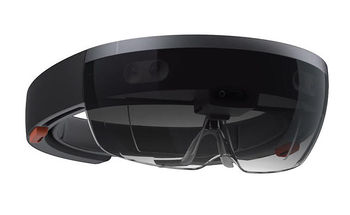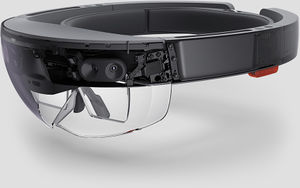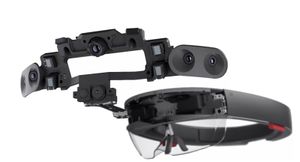Microsoft HoloLens

| |
|---|---|
| Creator | Alex Kipman |
| Developer | Microsoft |
| Manufacturer | Microsoft |
| Requires | Nothing |
| Predecessor | None |
| Successor | Microsoft HoloLens 2 |
| Operating System | Windows 10 |
| CPU | Intel 32 bit architecture |
| Display | 2 HD 16:9 light engines |
| Resolution | Holographic resolution: 2.3M total light points |
| Pixel Density | Holographic density: over 2.5k radiants (light points per radian) |
| Refresh Rate | 240Hz (60Hz content rate, each frame consists of four sequential colors: R-G-B-G) |
| Persistence | 2.5ms |
| Image | |
| Field of View | 30°H and 17.5°V |
| Optics | |
| Optics | See-through holographic lenses (waveguides) |
| Tracking | 6DOF |
| Rotational Tracking | Gyroscope, Magnetometer, Accelerometer |
| Positional Tracking | Depth Camera with 120°×120° FOV, 4 greyscale cameras |
| Latency | Motion to Photon: less than 2ms |
| Audio | Built-in speakers, Audio 3.5mm jack |
| Camera | 2MP photo / HD video camera, depth camera, 4 greyscale cameras |
| Connectivity | WiFi, Bluetooth |
| Power | Battery (2.5 to 5.5 hours per charge) |
| Sensors | ambient light sensor, array of 4 microphones |
| Input | Gaze, Gesture, Voice, HoloLens Clicker, Keyboard, Mouse |
| Cable Length | Wireless |
Contents
General Information
Microsoft HoloLens runs a self-contained Windows 10 computer. It features an HD 3D optical head-mounted display, spatial sound projection and advanced sensors to allow its users to interact with AR applications through head movements, gestures and voices. Microsoft has said that “The key to a great holographic experience is holograms that are light point rich, i.e. have a high holographic density, and are pinned or anchored to the world around you. To achieve this, HoloLens has been designed for optimal holographic density of 2.5K radiants. The more radiants and light points there are, the brighter and richer the holograms become.” [3]
HoloLens has various sensors and a high-end CPU and GPU, which Microsoft says gives the headset more processing power than an average laptop. [3]
The potential uses of the HoloLens are vast. From social apps to games, to navigation, there’s an incredible potential that this mixed reality device can tap into. Indeed, Microsoft collaborated with NASA in the making of HoloLens, and there is the potential to control the Mars rover Curiosity via the headset, allowing Nasa staff to work as if they were on the planet themselves. Microsoft also partnered with Volvo to showcase another possible use - using it in car showrooms for customers to view different color configurations for their chosen car and see features in action. [3]
At the end of March 2016, holoportation was showcased. The video demonstration showed how it could be possible - through the use of multiple cameras - to use the HoloLens to view a 3D version of a person. [3]
While the HoloLens price is high, it is an impressive piece of hardware and indicates that Microsoft is taking the augmented reality and virtual reality markets seriously. [4]
Announcement and Release
Microsoft HoloLens was announced during a Windows 10 Event on January 21st, 2015. The Development Edition was released on March 30, 2016, for $3,000 or £2,000. It allowed developers to start making apps and games for the headset. Months later, it became available to anyone with a Microsoft account. During the last quarter of 2016, the program expanded beyond the United States into countries like the United Kingdom, Ireland, France, Germany, Australia and New Zealand. Currently, there’s still no information regarding a consumer edition release date. [4] [3] [5]
Features
Holograms - realistic 3D projections that can be anchored onto real life objects. These virtual objects are projected at about 60 cm (near plane) to few meters.
Spatial Mapping - scans the environment in real time to create a mesh of an X/Y/Z coordinate plane. Objects can be accurately projected into the mesh.
Spatial Audio - in-app audio will come from different directions which depend on where you are in relation to the virtual object making the sound
Voice Recognition - recognizes various voice commands.
Gesture Recognition - recognizes various gesture commands such as the Air Tap.
Gaze Recognition - HoloLens tracks your gaze.
Hardware
Review
Headset and Display
HoloLens requires neither cords nor phones. It features an optical HMD on top of a plastic ring that wraps around the head. The plastic ring has a soft foam cushion on the inside. Like other HMDs, the weight of HoloLens is front loaded and feels a bit bulky. HoloLens can be used with most prescription glasses.
The transparent dual displays are made of three layers of glass (red, blue and green). A light engine is mounted above the displays and projects light on the lenses. The tiny corrugated grooves in each layer of glass diffract these light particles, making them bounce around and helping to trick your eyes into perceiving virtual objects at virtual distances.
The field of view where the holograms appear is quite small - 30° horizontal and 17.5° vertical. It is the same as a 16:9 monitor with 15 feet diagonal, 2 feet away from you face.
Sensors
Sensors include head tracking IMUs (Inertial Measuring Unit); a sound capture system consisting of an array of 4 microphones; an energy efficient depth camera with 120°×120° FOV, an RGB 2-megapixel photo / HD video camera and an ambient light sensor. Additionally, it has 4 greyscale environment sensing cameras that work with the depth camera to track the head, hands and the surrounding environment.
Processors
For processors, in addition to CPU and GPU, HoloLens possess an HPU, (holographic processing unit). The HPU is a coprocessor dedicated to integrating real world and virtually generated content. It consolidates and processes all the data from various sensors and produces a thin stream of useful information to the other processors. HPU removes the burden of handling heavy external data from the CPU and GPU, allowing them to focus on creating content.
HPU - processes all of the data from its sensors, depth camera, microphone etc.
Audio
The Spatial sound system consists of 2 small speakers are located on the sides of the OHMD, sitting above the ears. Unlike headphones, these speakers do not prevent the user from hearing external sounds. In-app audio will come from different directions which depend on where you are in relation to the virtual object making the sound.
Input and Interface
A pair of buttons responsible for brightness is above the left ear while another pair of buttons responsible for volume is above the right ear. In each pair, one of the buttons is concave while the other one is convex. There is also a Power button. These are the only physical inputs - HoloLens is largely controlled by voice, gesture and gaze along with a bluetooth clicker
5 LEDs are present on the left side of the OHMD. These LEDs display various system statuses such as power and battery conditions. A microUSB port is present for charging and connection. It is possible to use Microsoft HoloLens while it’s charging over microUSB. [3]
Power and Connectivity
The battery in HoloLens lasts around 2.5 hours during processor intensive use. It lasts around 5.5 hours during regular use.
HoloLens can connect to any WiFi or Bluetooth-equipped device.
HoloLens can run any universal Windows 10 app.
In the Box
- HoloLens Development Edition
- HoloLens Clicker
- Carrying case
- Charger and cable
- Microfiber cloth
- Nose pads
- Overhead strap
Specifications
| Part | Spec |
|---|---|
| CPU | Intel 32 bit architecture |
| GPU | ?? |
| HPU | Custom-built Microsoft Holographic Processing Unit (HPU 1.0) |
| RAM | 2 GB |
| Storage | 64 GB Flash |
| Display | 2 HD 16:9 light engines |
| Optics | See-through holographic lenses (waveguides) |
| IPD | Automatic pupillary distance calibration |
| Holographic Resolution | 2.3M total light points |
| Holographic Density | >2.5k radiants (light points per radian) |
| Field of View | 30°H and 17.5°V |
| Cameras | 2 Mega-pixel photo / HD video camera, depth camera, 4 greyscale environment understanding cameras |
| Sensors | ambient light sensor, 4 microphones |
| Tracking | 6 degrees of freedom |
| Rotational tracking | Gyroscope, Magnetometer, Accelerometer |
| Positional tracking | depth camera, 4 greyscale environment understanding cameras |
| Update Rate | |
| Tracking Volume | |
| Latency | Motion to Photon: less than 2ms |
| Audio | Built-in speakers, Audio 3.5mm jack |
| Connectivity | Wi-Fi 802.11ac, Micro USB 2.0, Bluetooth 4.1 LE |
| Power | Battery: 2-3 hours of active use, Up to 2 weeks of standby time |
| Weight | 579g |
| User Input | Gaze, voice, gesture |
| Buttons | Brightness, volume, power |
| OS | Windows 10 |
Setup Tutorial
Commands
Gaze
HoloLens tracks your gaze. When you perform a gesture such as air tap, look at the part of hologram where you want to place your tap.
Gesture
| Action | Description | Effect |
|---|---|---|
| Air Tap | With your index finger pointed upward, bend it forward | Simulates a mouse click in a desktop environment. Activates the interactive component |
| Home/Start | Opening your hand with palm facing up | Simulates the Windows key on a keyboard or Home button on a Windows Tablet. Opens up the holographic start menu. |
Voice
Microsoft's virtual assistant Cortana is incorporated into the HoloLens. Users can interact with her with natural language commands.
| Action | Effect |
|---|---|
| "Follow me" | The window follows the user, along the wall. |
Input Devices
HoloLens Clicker - a small clicker with a loop that wraps around your middle or index finger. It is held with the microUSB port towards your body and your thumb resting on top of the click, in the indentation. The clicker features a single button and rotational tracking. It allows a user to click and scroll with minimal hand motion as a replacement for the air-tap gesture.
Bluetooth Mouse and Keyboard
Apps
HoloLens can project various Windows 10 Apps, programs, and browsers onto walls and other objects. One of the examples Microsoft used was Windows-like interfaces projected onto walls and furniture. Users can interact with these projections with gaze, gestures and voice commands.
Holo Studio - Allows the user to create 3D models used for 3D Printing. In addition to gesture commands, it also accepts voice commands.
Minecraft - An Augmented reality version of Minecraft.
Project Xray - A mixed reality shooter game.
Actiongram - Place 3D models into real world environments and record videos with them, mixing reality with digital overlays.
HoloGuide - Guides a user through low visibility areas.
HoloHear - Instantly translates speech into sign language for deaf people.
Teomirn - Overlays prompts and instructions on a real piano to help people learn how to play. [4]
Developer
Windows Mixed Reality is Microsoft's AR platform incorporated in Windows 10 OS. Windows Mixed Reality API is implemented in all devices running Windows 10 including smartphones and tablets.
To develop for HoloLens, you need a Windows 10 PC able to run Visual Studio 2015 and Unity.
Tools
HoloLens Emulator
HoloLens Emulator allows the user to test Holographic apps on their PCs without the need of a physical HoloLens. The human and environmental inputs that would usually be read by the sensors on the HoloLens are instead simulated using your keyboard, mouse, or Xbox controller. Apps don't need to be modified to run on the emulator and don't know that they aren't running on a real HoloLens. [6]
History
January 21, 2015 - Microsoft HoloLens was officially announced.
April 28, 2015 - First live stage presentation of the HoloLens.
March 30, 2016 - Developer Edition of the HoloLens is officially released.
Images
References
- ↑ Microsoft. Microsoft HoloLens. Retrieved from https://www.microsoft.com/en-us/hololens
- ↑ Microsoft. Why HoloLens. Retrieved from https://www.microsoft.com/en-us/hololens/why-hololens
- ↑ 3.0 3.1 3.2 3.3 3.4 3.5 Roberts, J. (2016). What is HoloLens? Microsoft’s holographic headset explained. Retrieved from http://www.trustedreviews.com/opinion/hololens-release-date-news-and-price-2922378
- ↑ 4.0 4.1 4.2 Sophie, C. (2017). Microsoft HoloLens: Everything you need to know about the $3,000 AR headset. Retrieved from https://www.wareable.com/microsoft/microsoft-hololens-everything-you-need-to-know-about-the-futuristic-ar-headset-735
- ↑ Spence, E. (2017). Microsoft HoloLens Review: Winning the reality wars. Retrieved from https://www.forbes.com/sites/ewanspence/2017/01/14/microsoft-hololens-review-experience-review/2/#4053cf3d43f9
- ↑ Microsoft. Using the HoloLens emulator. Retrieved from https://developer.microsoft.com/en-us/windows/holographic/using_the_hololens_emulator



